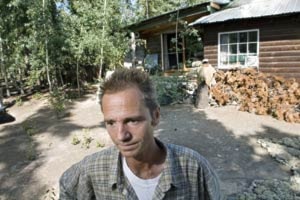The corner of Tim Zeigdel’s cabin is going to be chopped off.
The Yukon government is developing 20 lots off Takhini Hot Springs Road.
And Zeigdel’s Gruberville cabin is in the way.
Standing in his yard beside a sculpted reindeer moss garden, Zeigdel points at the red survey pins that mark a line transecting his home.
“When the surveyors came by, they told me they were going to have to cut the corner off my cabin,” said Zeigdel.
“I won’t even be able to walk around in my yard anymore.”
In the distance, you can hear the drone of heavy machinery.
“They’re clearing the land as we speak,” said Zeigdel.
“They could show up here any day.”
“Those big machines are making a real mess,” said Zeigdel’s neighbour Al Simon-Legree, who ambled over and joined the conversation.
“Those new lots are going to block off our trails and roads back there.”
They are also going to block off our yards, said Zeigdel.
“A new house will be built right here,” he said pointing at his fire pit.
“That’s why we had to move our outhouse.”
Simon-Legree was surprised.
“That’s the first I heard of it,” he said.
“Nobody told me that at any of the meetings.”
He pointed back toward the droning machines.
“I thought the new lots were going in way back there,” he said.
“I didn’t know they’d be right here.”
The proposed development was described in various e-mails, newsletters and flyers distributed last summer, Lake Laberge MLA Brad Cathers wrote in an e-mail to Zeigdel.
“I asked that anyone with concerns please contact me so that I could go to work on trying to have their concerns addressed,” he wrote.
“Following discussions with constituents who contacted me, I lobbied for changes — including more green space and buffer areas, and relocation of both access roads.
“The final lot plan was changed significantly to address concerns of my constituents.”
But some of his constituents still have concerns.
The buffer zone is in the wrong place, said Zeigdel.
On the proposed re-zoning map the buffer zone in question runs between the Grubber’s lot and the access road.
It was supposed to run between their property and the next lot, said Zeigdel.
“But the land’s branch made a mistake and now they won’t admit it.”
It’s a government money-grab, said Mayo Road resident Irene Organ, whose lot will be surrounded by the new development.
“How can they justify charging double and triple what these lots are worth?”
Last year Irene and her husband Eldon Organ had their property appraised.
Their six-hectare property, complete with power, well and septic came in at roughly $50,000, without the house.
But the new, four-hectare lots, without septic, water or hydro are going for $90,000 to $130,000.
“How can a person driving a truck around town for $15 an hour afford a lot for $130,000, then build a home for another $200,000 — that’s two mortgages,” said Organ.
“All the government should get for a lot is what it puts into it.”
With 20 lots, at roughly $100,000 — that’s $2 million — does it cost that much to put in a road and power line? asked Organ.
“There should be a base price for lots. So, land is available for people in the $40,000 a year range, not just the $80,000 range.
“These lots are robbery.”
Market value is taken into consideration when setting lot prices for all land in the territory, said community services spokesperson Doug Caldwell.
“And market value, in real estate, is all the traffic will bear.”
Typically, in residential areas, lot development costs are lower than market value, said Caldwell.
But the government prices the lots at market value to be fair to the marketplace, he said.
“We have to be fair to everyone, the real-estate industry, the developers, all those people — this is one of the driving forces of the territories economic engine.
“Charging just the cost of developing the lots is not going to be fair to the real estate industry, because you’re low-balling it.”
The high cost of the Hot Springs lots is not the Organs only concern.
“It’s a rush job,” said Organ.
“And it’s a Band-Aid solution to the land shortage, to make it look like the government’s doing something — it’s a quick fix.”
Although it’s called the Hot Springs Road development, the new subdivision’s main access will be off the Mayo Road.
“But it’s called the Takhini Hot Springs development because lots off the Mayo Road can’t be smaller than 15 acres and can’t be subdivided,” said Organ, who applied to subdivide two years ago and was told Mayo Road area regulations wouldn’t allow it.
Although the Organs’ lot will be surrounded on two sides by one of the new lots, they were not involved in any of the government’s pre-emptive consultations.
“They had meetings with some of the Hot Springs residents, but because we’re on the Mayo Road, they didn’t consult us,” said Organ.
“In his letter, Cathers told me he had lots of consultations, but I don’t know who with,” said Zeigdel.
The survey line that transects the corner of Zeigdel’s cabin was drawn years after the cabin was built, he said.
“Nobody came and saw how close the line was till after the fact,” said Zeigdel.
“They’re doing things blindly.
“I’m not against development, all I’m asking is that they give us a buffer between what already exists and the new lots.
“And the government shouldn’t be making a profit off land.”
